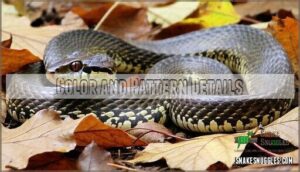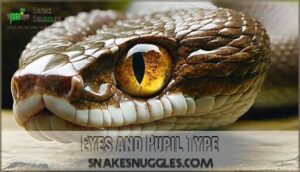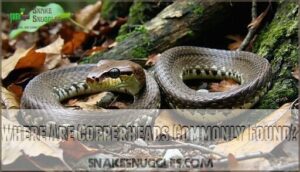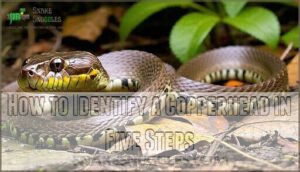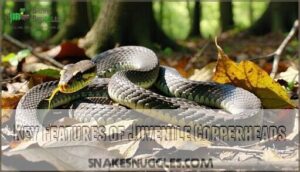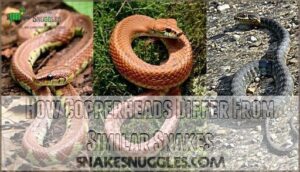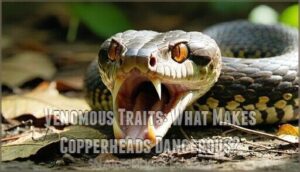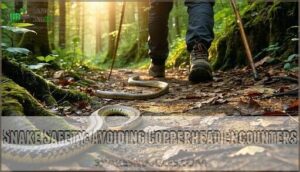This site is supported by our readers. We may earn a commission, at no cost to you, if you purchase through links.
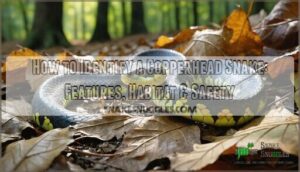 A copperhead doesn’t announce itself with a warning rattle or a flash of color. Instead, it waits—still as old bark, blending perfectly with leaf litter and dappled woodland shadows. That uncanny camouflage is why so many hikers get startled, catching sight of the hourglass bands only when they’re nearly on top of them.
A copperhead doesn’t announce itself with a warning rattle or a flash of color. Instead, it waits—still as old bark, blending perfectly with leaf litter and dappled woodland shadows. That uncanny camouflage is why so many hikers get startled, catching sight of the hourglass bands only when they’re nearly on top of them.
Knowing how to identify a copperhead snake isn’t trivia; it’s a skill that keeps your hikes uneventful and your family safe. With a trained eye and a bit of field sense, you’ll learn to spot every subtle clue before your next step brings you too close.
Table Of Contents
- Key Takeaways
- What Does a Copperhead Snake Look Like?
- Where Are Copperheads Commonly Found?
- How to Identify a Copperhead in Five Steps
- Key Features of Juvenile Copperheads
- How Copperheads Differ From Similar Snakes
- Venomous Traits: What Makes Copperheads Dangerous?
- Snake Safety: Avoiding Copperhead Encounters
- The Role of Copperheads in The Ecosystem
- When and Why Do Copperheads Bite?
- Frequently Asked Questions (FAQs)
- How do you know if a snake is a Copperhead?
- How to properly identify a Copperhead snake?
- Is a baby Copperhead a snake?
- What if I see a Copperhead?
- How Venomous is a Copperhead Snake?
- What is the Average Lifespan of a Copperhead Snake?
- Are Copperheads Aggressive Towards Humans?
- Do Copperhead Snakes Make Good Pets?
- Can Copperhead Snakes Be Found in Urban Areas?
- How can you tell if a snake is a copperhead?
- Conclusion
Key Takeaways
- You can identify a copperhead by its hourglass-shaped brown crossbands, triangular coppery head, and vertical, cat-like pupils.
- Copperheads rely on camouflage and are most common in wooded, rocky areas across the central and eastern United States.
- Juvenile copperheads have a bright yellow tail tip for luring prey and display bolder body patterns than adults.
- Staying alert, wearing boots, and avoiding hidden areas are the best ways to prevent unwanted encounters or bites.
What Does a Copperhead Snake Look Like?
Identifying a copperhead starts with recognizing three key physical features that set this venomous snake apart from harmless look-alikes. These characteristics remain consistent across age groups and geographic regions, making them reliable markers for field identification.
Let’s examine the color patterns, body structure, and eye details that define this species.
Color and Pattern Details
The copperhead’s most recognizable feature is its distinctive hourglass-shaped crossband pattern, rendered in darker brown against a pale tan to brown body that fades subtly toward the belly. These crossbands usually appear broken along the spine rather than connecting fully, enhancing the snake’s camouflage methods in leaf litter.
The coppery-tan coloration extends across both the head and body, making pattern recognition your most reliable tool for visual identification in woodland habitats.
Head and Body Shape
Beyond the camouflage pattern, you’ll notice the copperhead’s head is distinctively triangular, widening at the base to accommodate specialized venom glands and retractable fangs. This diamond-shaped head contrasts sharply with the narrower neck, creating what herpetologists call a "spade-like" appearance.
The body itself tapers smoothly from a moderately thick midsection toward the tail, displaying keeled scales that create a subtly rough texture rather than the glossy smoothness you’d find on non-venomous species.
Eyes and Pupil Type
Look closely at the eyes, and you’ll spot one of the most reliable field marks—a vertical, elliptical pupil set against a pale yellow or coppery iris. These catlike eyes differ dramatically from the round pupils typical of harmless snakes.
The vertical pupil shape, combined with the distinctive eye color, helps you identify venomous pit vipers from a safe distance, making snake eye pupil identification a vital skill in the field.
Where Are Copperheads Commonly Found?
Knowing where copperheads live helps you stay alert in the right places. These snakes occupy a surprisingly wide range across the U.S., with distinct preferences for certain habitats and seasonal patterns.
Let’s look at their geographic distribution, favorite environments, and when they’re most active.
Geographic Range in The U.S
If you’ve ever wondered where Eastern Copperheads and their relatives actually live, you’ll find them spread across 28 U.S. states, primarily in the central and eastern regions. Regional distribution stretches from southern New England down to the Florida panhandle and west to eastern Kansas and Nebraska. Habitat fragmentation and geographic isolation limit their range expansion, keeping copperhead snake habitat and distribution confined to specific zones.
Key facts about copperhead snake species distribution:
- Northern copperhead — the most widespread subspecies, ranging from Massachusetts to the Florida panhandle
- Oklahoma hosts four subspecies — the highest diversity of any state, where multiple copperhead migration patterns overlap
- Texas has three distinct types — broad-banded, southern, and Trans-Pecos copperhead occupy different regions
- Absent from the upper Midwest and Southwest — no copperheads in Wisconsin, North Dakota, California, or Alaska due to climate and historical limitations
You won’t find copperheads in heavily urbanized areas or extensive agricultural landscapes. Snake habitats concentrate in the Appalachian region, much of the southeastern U.S., and central Texas, where encounter probability remains highest. Understanding their venomous species characteristics is vital for safety and identification.
Preferred Habitats
You’ll encounter copperhead snake habitats where forest floors meet rocky terrain and transitional zones. Deciduous and mixed woodlands with dense leaf litter support 85% of northeastern sightings, while rocky outcrops serve as communal den sites in 92% of Appalachian studies.
Woodland edges, wetland areas near swamp margins, and surprisingly, suburban spaces like wood piles create ideal copperhead snake habitat and distribution. Males favor forest-field boundaries 60% more than dense pine stands, demonstrating preference for diverse snake habitats.
Copperheads often thrive in areas with suitable heat sensing organs.
Seasonal and Daily Activity Patterns
Throughout the year, copperheads shift their schedules like clockwork, hunting during daylight hours in spring and fall but switching to nocturnal prowling once summer heat arrives. This nocturnal behavior keeps them cool while tracking prey. Their activity cycles tie directly to temperature, with seasonal hibernation beginning when ground temps drop below 50°F.
Key copperhead snake behavior patterns:
- Spring emergence triggers diurnal hunting near den sites where they intercept migrating rodents
- Summer nights see crepuscular activity cycles peaking between 10 PM and 2 AM in woodland edges
- Fall aggregation drives increased daily movement toward communal hibernacula shared with other snake species
How to Identify a Copperhead in Five Steps
When you’re out in the field, knowing how to identify a copperhead quickly can make all the difference. A systematic approach helps you distinguish these venomous snakes from harmless look-alikes with confidence.
Here’s a practical checklist you can follow from a safe distance to confirm what you’re seeing.
Step-by-Step Visual Checklist
When identifying a copperhead snake, you’ll want to check five key characteristics in sequence. Start by examining the overall pattern and coloration—look for those distinctive hourglass-shaped crossbands in dark brown against a tan or copper base. Next, check the head shape; copperheads have a triangular, almost spade-like head. Third, observe the eyes closely for vertical, cat-like pupils. Fourth, look for the heat-sensing loreal pits between each eye and nostril—these are diagnostic of pit vipers. Finally, if you’re observing a juvenile, check for that bright yellow tail tip used as a prey lure.
| Feature | What to Look For | Why It Matters |
|---|---|---|
| Body Pattern | Sideways hourglass crossbands, tan to copper background | Most reliable visual cue for copperhead identification |
| Head Shape | Triangular with pronounced ridge above eye | Houses venom glands and fangs |
| Eye Pupils | Vertical, cat-like slits | Distinguishes venomous from most non-venomous species |
| Heat Pits | Two pits between eyes and nostrils | Confirms pit viper identification |
This systematic approach to snake identification using visual cues and pattern recognition helps you identify copperheads accurately from a safe distance.
Safety Tips for Observation
When you’re observing any snake in the wild, keeping at least six feet of distance isn’t just smart—it’s the difference between safe identification and a potential medical emergency. Follow these snake safety precautions to protect yourself:
- Watch for warning signs like defensive tail vibration or a coiled posture, which signal the snake feels threatened and may strike.
- Never reach into unseen areas such as log piles, dense ground cover, or rock crevices where copperheads commonly hide.
- Wear protective gear including closed-toe boots and long pants when hiking through copperhead habitat, especially during their active hours at dawn and dusk.
These observation tips guarantee venomous snake safety while allowing you to practice snake awareness in outdoor settings and enable emergency response if needed.
Key Features of Juvenile Copperheads
Young copperheads aren’t just miniature versions of adults—they come with their own distinctive markers that can help you tell them apart in the field. The most obvious difference is that sulfur-yellow tail tip, which has a specific purpose you won’t see in grown snakes.
Here’s what sets juveniles apart from their older counterparts.
Tail Color and Function
Young copperheads come equipped with a built-in fishing lure—a sulfur-yellow tail tip that wiggles like a tasty grub to draw curious frogs, lizards, and insects within striking range. This juvenile tail fading behavior is caudal luring, where the yellow tail tip mimics prey movement.
As your juvenile snakes mature into adults over several years, that bright signal gradually dulls and disappears, no longer needed once they’re large enough to hunt without trickery.
Pattern Differences From Adults
Beyond that eye-catching tail, juvenile copperheads show bolder, more vibrant crossband patterns than their parents, making them easier to spot in the leaf litter. These young snakes display sharper contrast between their hourglass-shaped bands and background coloration.
As juvenile copperheads grow, pattern fading occurs gradually—the dark crossbands become less distinct and the overall snake pattern and coloration mutes to the subtler adult appearance that blends seamlessly into forest floors.
How Copperheads Differ From Similar Snakes
Copperheads are frequently mistaken for several harmless species, which can lead to unnecessary alarm or, worse, dangerous mishandling of non-venomous snakes.
Understanding the specific differences between copperheads and their look-alikes will help you make accurate identifications in the field.
Here’s how to distinguish copperheads from three commonly confused species.
Eastern Ratsnake Vs. Copperhead
At first glance, the Eastern Ratsnake can easily fool you—its blotched juvenile pattern resembles what you’d expect on a copperhead. However, pattern comparison reveals the truth: copperheads display hourglass-shaped crossbands extending down their sides, while ratsnakes show blotches concentrated near the backbone.
Head shape differs dramatically—copperheads have broad, triangular copper-colored heads; ratsnakes possess elongated heads with pale chins. Venomous status separates these species entirely, as Eastern Ratsnakes are harmless.
Check pupil shape and heat pits for confirmation: copperheads have vertical pupils and heat-sensing pits between eye and nostril, while ratsnakes have round pupils and lack sensory pits. Adult ratsnakes turn uniformly black, making snake identification simpler with mature specimens.
Northern Watersnake Vs. Copperhead
Northern Watersnake confusion runs high near rivers and ponds—you’ll encounter harmless snake identification challenges when band patterns look superficially similar. Copperheads display hourglass-shaped bands, while watersnakes show bulb-shaped markings.
Pupil shape confirms identity: copperheads possess vertical pupils; watersnakes have round pupils. Swimming behavior differs noticeably—copperheads swim with elevated heads, watersnakes dive when startled.
Head shape and venom comparison separate these species: copperheads maintain copper-colored triangular heads with heat-sensing pits, watersnakes flatten their heads defensively but lack venom entirely.
Eastern Milksnake Vs. Copperhead
Eastern Milksnake patterns create frequent misidentification—you’ll notice square-like blotches bordered in black, unlike copperhead hourglass bands starting on the sides. Neck markings distinguish milksnakes: look for distinctive "V", "U", or "Y" shapes copperheads lack.
Key identification features for Copperhead snake identification and harmless snake identification:
- Blotch shape: Milksnakes show square blotches; Eastern Copperhead displays sideways hourglasses
- Body cross-section: Milksnakes appear round; copperheads show oblong profiles
- Head width: Milksnake heads barely exceed neck width; copperheads possess broad triangular heads
- Neck markings: Milksnakes feature letter-shaped neck patterns absent in Eastern Copperheads
- Venom comparison: Milksnakes lack venom entirely; copperheads are venomous pit vipers
Venomous Traits: What Makes Copperheads Dangerous?
Copperheads aren’t just venomous—they’re equipped with specialized anatomy that makes them efficient predators and, when necessary, formidable defenders. Understanding their venom delivery system, sensory adaptations, and the real risks of envenomation helps you appreciate why caution matters.
Let’s examine three key traits that define their danger.
Venom Glands and Fangs
Copperheads pack their venom in specialized glands that sit behind those distinctively wide, triangular heads, connected to hollow, retractable fangs that work like hypodermic needles. When the snake bites, muscles squeeze the venom glands, forcing snake venom through the fang structure and into prey or threats.
The venom composition includes hemotoxins that break down tissue, though antivenom research has made copperhead bites rarely fatal. You’ll see the fangs fold back against the roof of the mouth when not deployed, a key feature of venom delivery mechanics in pit vipers.
Heat-Sensing Pits
Right between the eye and the nostril, you’ll spot a small, subtle pit—almost like a secret tool for sensing the warmth of passing prey. To understand how this copperhead advantage works, remember:
- Pit Function: infrared detection
- Prey Location: tracks mammals in darkness
- Nocturnal Hunting: boost for night activity
- Pit Development: functional from birth
- Pitvipers: all venomous snakes in this group share it
Bite Symptoms and Risks
Ever wondered how serious a copperhead snake bite can get? Most snake bite symptoms appear fast—sharp local pain, swelling, and redness—but systemic effects like dizziness or nausea are rare. Risk factors include age and immune health.
Thankfully, most bite severity is mild, delayed symptoms are unusual, and snake bite treatment nearly always results in full recovery if you seek snake bite first aid quickly.
Snake Safety: Avoiding Copperhead Encounters
Regarding copperheads, a little caution goes a long way. Knowing how to keep yourself safe outdoors can make all the difference. Here’s what you should keep in mind.
Precautions in Snake Habitats
If you’re headed into thick brush or poking around wood piles, wouldn’t you rather know what’s hiding at your feet? Copperhead habitats deserve your respect.
Try these precautions for snake safety and bite prevention:
- Wear boots and gloves for protective gear
- Keep to open trails for trail safety
- Avoid walking barefoot at night
- Teach child safety outdoors
- Stay alert for hidden wildlife
Safe Behavior Outdoors
Staying snake-smart outdoors isn’t just about luck—it’s about the choices you make every time you lace up your boots. Stick to Trail Safety habits, steer clear of dense ground cover in the garden, and keep kids and pets in sight.
Night Awareness is key; flip on a flashlight. These snake safety measures help with snake bite prevention and make wildlife safety second nature.
What to Do if You Spot a Copperhead
Spotting a snake in your path can turn a quiet walk into a moment that makes your heart skip a beat—so what should you do next? Stay calm; don’t rush. Back away slowly to avoid startling the copperhead. Monitor pets nearby.
Call experts if the snake lingers. Report sightings for community safety.
Prioritize venomous snake awareness and don’t attempt snake bite first aid unless necessary.
The Role of Copperheads in The Ecosystem
Copperheads aren’t just another face in the crowd—they play a real part in the world around you. Knowing what they actually do in their natural environment can shift the way you see them.
Here’s how these snakes make their mark on the ecosystem.
Rodent Control Benefits
You might be surprised at how much copperheads tip the scales in favor of Ecosystem Balance. By preying on rodents, these snakes act as champions of Natural Pest Control—quietly curbing outbreaks that could damage crops or homes.
Copperheads help keep nature in balance by quietly controlling rodent populations and protecting crops through their natural hunting
Their presence helps keep rodent populations in check, which has a direct Agricultural Impact and plays an important role in Disease Control and snake ecology.
Interactions With Other Wildlife
Just as copperheads quietly address your rodent trouble, they also cross paths with plenty of other animals in the wild—and those encounters reveal even more about their place in nature.
- Shared dens with timber rattlesnakes in winter.
- Predator-prey dynamics with hawks and raccoons.
- Compete with other predators for rodents.
- Influence snake diet and ecosystem impact.
- Relate through subtle symbiotic relationships.
When and Why Do Copperheads Bite?
Understanding when a copperhead is likely to bite can help you avoid trouble outdoors. It’s usually not about aggression but more about how the snake feels in the moment.
Here’s what to know before reading the details below.
Typical Triggers for Biting
Often, a bite happens when you’ve wandered too close or stepped somewhere a snake was hoping to be left alone. Accidental contact is the biggest culprit. Picking up snakes or making sudden movements can turn a perceived threat into a Copperhead snake bite.
During hot months, seasonal aggression spikes. Most venomous snake bites are simply the result of not seeing what’s underfoot—prevention starts with awareness.
Defensive Behaviors
When a snake feels cornered or startled, it doesn’t usually go looking for trouble—it relies on a toolbox of defensive moves to protect itself and warn you away.
Copperheads may freeze in place, banking on their camouflage, or vibrate their tail as a clear warning. If pressed, they’ll strike only within close distance, often metering venom to conserve it.
Preventing Snake Bites
If you want to keep bites off the table, a little know-how and a dash of caution go a long way out in snake country. Stay sharp—awareness is your best defense, not luck.
For bite prevention and snake awareness in outdoor settings:
- Wear protective gear, especially boots.
- Never reach blindly into brush.
- Call for professional removal if a copperhead is spotted.
Frequently Asked Questions (FAQs)
How do you know if a snake is a Copperhead?
Like a well-worn penny amid stones, Copperheads stand out thanks to their coppery heads, hourglass body bands, and cat-like eyes.
Key identifiers include a triangular head shape, unique pattern variations, and habitat clues tied to venomous snake identification.
How to properly identify a Copperhead snake?
Focus on key identifiers like coppery bands, a triangular head, and hourglass pattern variations. Habitat clues matter, too—think brushy areas.
Learn behavior traits and Juvenile ID basics, making snake identification guides your go-to for venomous snake identification.
Is a baby Copperhead a snake?
Even the smallest apple doesn’t fall far from the tree—a baby copperhead is absolutely a snake. Born alive and fully equipped with venom, it uses its bright tail lure for hunting. Growth rate and juvenile diet soon follow.
What if I see a Copperhead?
Spot a copperhead? Keep a safe distance and avoid panic. Document the sighting, note the location, and call experts for safe removal.
Practicing snake awareness and reporting helps with venomous snake safety and snake bite prevention for everyone.
How Venomous is a Copperhead Snake?
Copperheads rank as less potent compared to other venomous snakes, but their venom still causes pain, swelling, and tissue damage. Bite severity varies.
Most healthy adults recover fully with prompt medical treatment, but effects on humans can be unpredictable.
What is the Average Lifespan of a Copperhead Snake?
As steady as clockwork, Copperheads in the wild live 10–15 years, with some reaching a maximum age of 20 in captivity.
Factors affecting lifespan include snake diet, habitat, behavior, and overall snake ecology and environment.
Are Copperheads Aggressive Towards Humans?
You’ll notice these venomous snakes tend to avoid human interaction and rarely act aggressively unless provoked. Most bite provocation results from perceived threats, not intent.
Defensive displays, not open hostility, characterize copperheads, making snake awareness and prevention critical outdoors.
Do Copperhead Snakes Make Good Pets?
Ever thought about keeping a venomous snake? With Copperheads, Captivity Challenges, Care Complexity, Temperament Issues, Ethical Concerns, and Legal Restrictions, the hurdles stack up fast.
Most experts agree: the risks to humans far outweigh any reward.
Can Copperhead Snakes Be Found in Urban Areas?
Urban habitats don’t exclude copperheads—they adapt where green spaces, brush, and woodpiles exist.
Suburban spread increases pet encounters and human interaction, so solid mitigation strategies and smart snake prevention can lower risks of unwelcome snake behavior close to home.
How can you tell if a snake is a copperhead?
Check for a coppery-tan head, hourglass-shaped bands along the back, and vertical pupils.
Observe habitat clues—copperheads like leaf litter and woodpiles.
Use expert verification for tricky pattern variations; behavior analysis helps with differentiating copperheads from harmless snakes.
Conclusion
You’re out on the trail, sunlight slanting through leaves, and every rustle keeps you guessing—was that a twig or something more? That single, uncertain moment is the reason learning how to identify a copperhead snake matters.
It’s not about fear, but about meeting nature on its own terms, confident and observant. Next time you cross into their quiet world, you’ll see what most hikers miss—and that one glance could make all the difference you never knew you needed.
- https://animaldiversity.org/accounts/Agkistrodon_contortrix/
- https://www.mass.gov/info-details/learn-about-copperheads
- https://en.wikipedia.org/wiki/Eastern_copperhead
- https://digitalcommons.odu.edu/cgi/viewcontent.cgi?article=1373&context=biology_etds
- https://jamanetwork.com/journals/jama/fullarticle/335424

